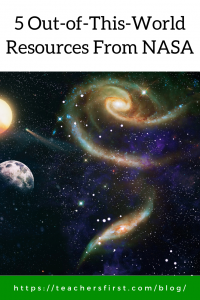Space Exploration Day is celebrated annually on July 20. It commemorates the first landing of the Eagle lunar module on the moon’s Sea of Tranquility. NASA’s contributions to exploring our world continue toward discovering new and exciting places in our universe.
We often talk about using primary sources in classrooms to promote student understanding of content—and what better primary source is there for teaching space science than NASA? NASA shares many different resources that support students and educators as they seek to understand planet Earth and beyond.
- Solar System Exploration (reviewed here) – Explore the solar system using this fantastic interactive. Click any location to learn about planets, comets, asteroids, and other celestial bodies. Many offer the opportunity to compare the item’s size to another. For example, click on any planet, then click Compare Size to select another object for comparison. In addition to the interactive, you can explore even more knowledge by scrolling down and opening the More area. This supplemental portion of the site provides an in-depth look at the solar system, additional topics for exploration, and superb image and video galleries. You and your students will enjoy exploring this comprehensive site to learn about our solar system.
- NASA Image and Video Library (reviewed here) – Use this image, video, and audio library for science projects and presentations. Find specific content using the search feature or browse through the site to find the newest or most popular additions. Each selection is available to download. Be sure to read and adhere to the usage guidelines provided.
- Eyes on the Earth (reviewed here) – Eyes on the Earth is another excellent interactive that provides real-time monitoring of the earth’s vital signs. Use the Latest Events feature to find satellite images of wildfires and superstorms. Choose from additional labels to view the earth’s air temperature, carbon monoxide levels, and other data. The video tutorial provides valuable information on using the many features available in this interactive.
- Hubble Site (reviewed here) – The home of the Hubble Telescope shares stunning images and information provided by the telescope launched in 1990. Scroll through the site to find pictures, mission information, and quick facts, or learn about the current Hubble schedule. Use the menu on each page to quickly navigate specific information about the Hubble Telescope.
- NASA for Educators: STEM Engagement (reviewed here) – Find lessons, educator guides, and interactive activities provided by NASA for teaching STEM topics to all grade levels. In addition to teaching resources, this site also includes opportunities for educators to participate in webinars and virtual tours. Choose from resource collections provided in grade-level bands. In addition to the items featured on the main website, you can use the dropdown boxes to find topics and resources for students and teachers that include activities by type or subject.
Use these interactives to help students explore and engage in learning about Earth and our solar system. Find images, videos, and resources for you and your students to use in projects and presentations. Other NASA resources offer standards-based lessons ready for use in your classroom.
These examples are just five of the many different resources NASA has provided to help us learn about the world around us. Thanks to the many hard-working scientists, explorers, and innovators throughout the years, we can teach our students about space using real-time images and activities.
What is your favorite resource created by NASA? We would love to hear how you use any of their sites in your classroom. As always, we enjoy hearing from our readers and learning together in the comments below.



One more site to visit from NASA. – the new Wells Telescope site. Learn about the telescope and view the AMAZING first images that were just released!
https://webb.nasa.gov/